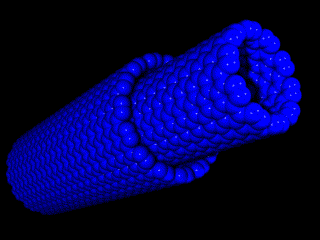
Zettl Research Group |
Research Project |

(click here for more pictures, and permissions)
We have developed techniques to open the end of a nanotube, attach a manipulator to the protruding core nanotubes, and slide the core nanotubes out, like telescoping a spyglass or a radio antenna. These experiments were performed using multi-wall carbon nanotube (you can learn a bit more here).
The techniques for peeling open the ends of a nanotube are described in a forthcoming article in the journal, Nature.
The techniques for making a linear bearing from a nanotube are described in our article in the 27 July, 2000 issue of the journal Science.
Once the outer layers of a nanotube have been peeled open, the manipulator can be brought into contact with just the core nanotubes. Then an electrical current pulse can be applied to spot-weld the core nanotubes to the manipulator (careful, too much current can damage the nanotubes). Then, with the manipulator attached to just the core nanotubes, pulling on the nanotube will slide out the core section, like a piston. The sliding motion is entirely reversible, and we have been able to repeat the motion up to twenty times on the same nanotube. Interestingly, the sliding motion does not affect the structure of the nanotubes. The TEM is capable of imaging the structure of nanotubes at atomic resolution, and we find that after extending a nanotube and retracting it back to the original position, the structure of the nanotube is unchanged after any number of cycles. From this, we infer that nanotube bearings are wear-free. We have also found that it is possible to break the spot-weld, releasing the nanotube core section. Surprisingly, once the nanotube core section is free, it spontaneously contracts back inside the outer nanotube housing. It does this because of microscopic atomic forces known as van der Waals forces. We calculate the van der Waals forces for a typical nanotube to be a mere 9 nanonewtons. From the fact that the nanotube spontaneously retracts, we can conclude that any friction forces present would have to be smaller than this. This implies that nanotubes could be used as nanoscale bearings with exceedingly small friction and low-wear. Additionally, the van der Waals force pulling the nanotube core back inside the housing is independent of the extension of the core section. Thus, a nanotube bearing in the partially extended geometry could be used as a constant-force spring.